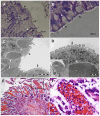Enterohemorrhagic Escherichia coli induce attaching and effacing lesions and hemorrhagic colitis in human and bovine intestinal xenograft models
- PMID: 20959635
- PMCID: PMC3014348
- DOI: 10.1242/dmm.005777
Enterohemorrhagic Escherichia coli induce attaching and effacing lesions and hemorrhagic colitis in human and bovine intestinal xenograft models
Abstract
Enterohemorrhagic Escherichia coli (EHEC) O157:H7 is an important cause of diarrhea, hemorrhagic colitis and hemolytic uremic syndrome in humans worldwide. The two major virulence determinants of EHEC are the Shiga toxins (Stx) and the type III secretion system (T3SS), including the injected effectors. Lack of a good model system hinders the study of EHEC virulence. Here, we investigated whether bovine and human intestinal xenografts in SCID mice can be useful for studying EHEC and host tissue interactions. Fully developed, germ-free human and bovine small intestine and colon were established by subcutaneous transplantation of human and bovine fetal gut into SCID mice. Xenografts were allowed to develop for 3-4 months and thereafter were infected by direct intraluminal inoculation of Stx-negative derivatives of EHEC O157:H7, strain EDL933. The small intestine and colon xenografts closely mimicked the respective native tissues. Upon infection, EHEC induced formation of typical attaching and effacing lesions and tissue damage that resembled hemorrhagic colitis in colon xenografts. By contrast, xenografts infected with an EHEC mutant deficient in T3SS remained undamaged. Furthermore, EHEC did not attach to or damage the epithelium of small intestinal tissue, and these xenografts remained intact. EHEC damaged the colon in a T3SS-dependent manner, and this model is therefore useful for studying the molecular details of EHEC interactions with live human and bovine intestinal tissue. Furthermore, we demonstrate that Stx and gut microflora are not essential for EHEC virulence in the human gut.
Figures







Similar articles
-
Enterohaemorrhagic Escherichia coli O157:H7 target Peyer's patches in humans and cause attaching/effacing lesions in both human and bovine intestine.Gut. 2000 Sep;47(3):377-81. doi: 10.1136/gut.47.3.377. Gut. 2000. PMID: 10940275 Free PMC article.
-
Pathogenesis of Colitis in Germ-Free Mice Infected With EHEC O157:H7.Vet Pathol. 2017 Jul;54(4):710-719. doi: 10.1177/0300985817691582. Epub 2017 Feb 8. Vet Pathol. 2017. PMID: 28178427 Free PMC article.
-
Critical roles for stx2, eae, and tir in enterohemorrhagic Escherichia coli-induced diarrhea and intestinal inflammation in infant rabbits.Infect Immun. 2003 Dec;71(12):7129-39. doi: 10.1128/IAI.71.12.7129-7139.2003. Infect Immun. 2003. PMID: 14638803 Free PMC article.
-
Regulation Mechanisms of Virulence Genes in Enterohemorrhagic Escherichia coli.Foodborne Pathog Dis. 2022 Sep;19(9):598-612. doi: 10.1089/fpd.2021.0103. Epub 2022 Aug 3. Foodborne Pathog Dis. 2022. PMID: 35921067 Review.
-
Interkingdom Chemical Signaling in Enterohemorrhagic Escherichia coli O157:H7.Adv Exp Med Biol. 2016;874:201-13. doi: 10.1007/978-3-319-20215-0_9. Adv Exp Med Biol. 2016. PMID: 26589220 Review.
Cited by
-
LysR-type transcriptional regulator OvrB encoded in O island 9 drives enterohemorrhagic Escherichia coli O157:H7 virulence.Virulence. 2019 Dec;10(1):783-792. doi: 10.1080/21505594.2019.1661721. Virulence. 2019. PMID: 31502495 Free PMC article.
-
Xenotransplantation models to study the effects of toxicants on human fetal tissues.Birth Defects Res B Dev Reprod Toxicol. 2014 Dec;101(6):410-22. doi: 10.1002/bdrb.21131. Epub 2014 Dec 4. Birth Defects Res B Dev Reprod Toxicol. 2014. PMID: 25477288 Free PMC article. Review.
-
Intimate host attachment: enteropathogenic and enterohaemorrhagic Escherichia coli.Cell Microbiol. 2013 Nov;15(11):1796-808. doi: 10.1111/cmi.12179. Epub 2013 Sep 3. Cell Microbiol. 2013. PMID: 23927593 Free PMC article. Review.
-
NF-kappa-B activation unveils the presence of inflammatory hotspots in human gut xenografts.PLoS One. 2021 May 3;16(5):e0243010. doi: 10.1371/journal.pone.0243010. eCollection 2021. PLoS One. 2021. PMID: 33939711 Free PMC article.
-
Cellular and Mucosal Immune Responses Following Vaccination with Inactivated Mutant of Escherichia coli O157:H7.Sci Rep. 2019 Apr 22;9(1):6401. doi: 10.1038/s41598-019-42861-z. Sci Rep. 2019. PMID: 31024031 Free PMC article.
References
-
- Cantey J.R., Inman L.R., Blake R.K. (1989). Production of diarrhea in the rabbit by a mutant of Escherichia coli (RDEC-1) that does not express adherence (AF/R1) pili. J. Infect. Dis. 160, 136–141 - PubMed
-
- Chong Y., Fitzhenry R., Heuschkel R., Torrente F., Frankel G., Phillips A.D. (2007). Human intestinal tissue tropism in Escherichia coli O157: H7-initial colonization of terminal ileum and Peyer’s patches and minimal colonic adhesion ex vivo. Microbiology 153, 794–802 - PubMed
-
- Croxen M.A., Finlay B.B. (2010). Molecular mechanisms of Escherichia coli pathogenicity. Nat. Rev. Microbiol. 8, 26–38 - PubMed
Publication types
MeSH terms
Substances
LinkOut - more resources
Full Text Sources
Medical

